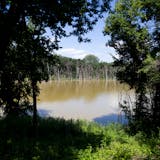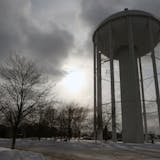On George Washington's childhood farm in Virginia, archaeologist Phil Levy is telling me the famous folk tale about young George confessing that he had destroyed his father's favorite cherry tree with his hatchet.
But Levy's nowhere in sight. It's just me, an iPad and a whole lot of cicadas in the middle of a dewy field, which was part of the Washington family's 580-acre estate near Fredericksburg, Va., in the mid-1700s.
Thanks to an interactive iPad tour, I'm taking the experts along with me on my ramble around Ferry Farm. It's a place I've wanted to visit since 2008, when I heard that archaeologists had unearthed the foundation of the house where George Washington lived from age 6 until his early 20s.
But because Ferry Farm has few visible remnants of the Washingtons' time, it's hard for tourists to relate to what life was like back then.
"There's a disconnect between our resources, our collection and our landscape," said David Muraca, the George Washington Foundation's director of archaeology. "There are elements of the Washington landscape out there, but you can't explain them in the 15 words that people are normally used to reading in signs."
So in March, the foundation launched the iPad app "Uncovering George Washington's Youth." It includes 10 interactive stops around the property, many accompanied by narrated videos, photographs, old maps, paintings, drawings — even George's geometry homework. (Alas, non-Apple people are out of luck; there are no plans to make an app for other devices.)
I picked up an iPad at the visitor center — you can bring your own and download the app if you prefer — and started my tour in a vibrant garden just outside.
The garden wasn't here in the 1700s, but the app displays plants that a well-to-do colonial family would have grown: tobacco, cotton, potatoes, herbs, and yes, cherry trees. I clicked through for a photo gallery of plants and their historic uses. (Rosemary sweetens foul breath, for instance.)


